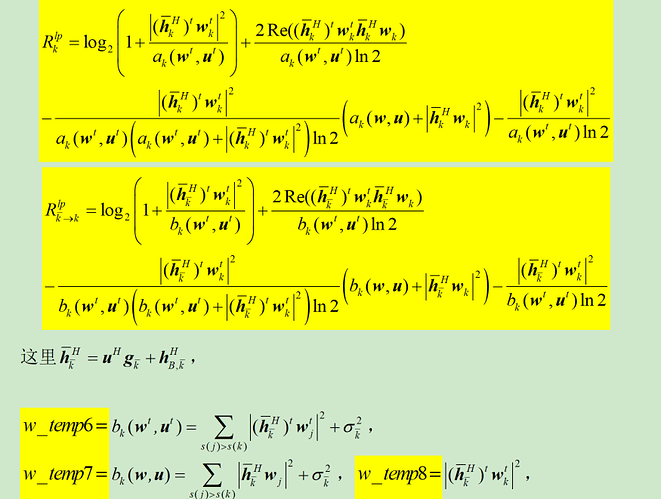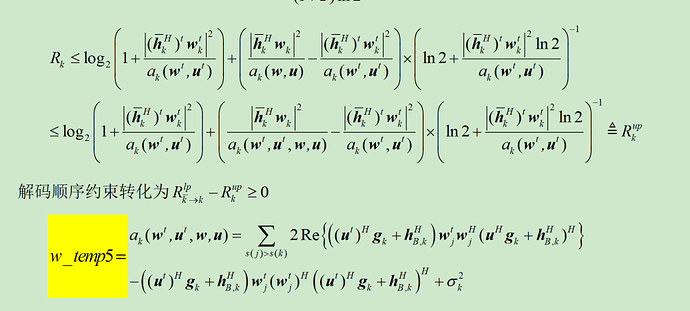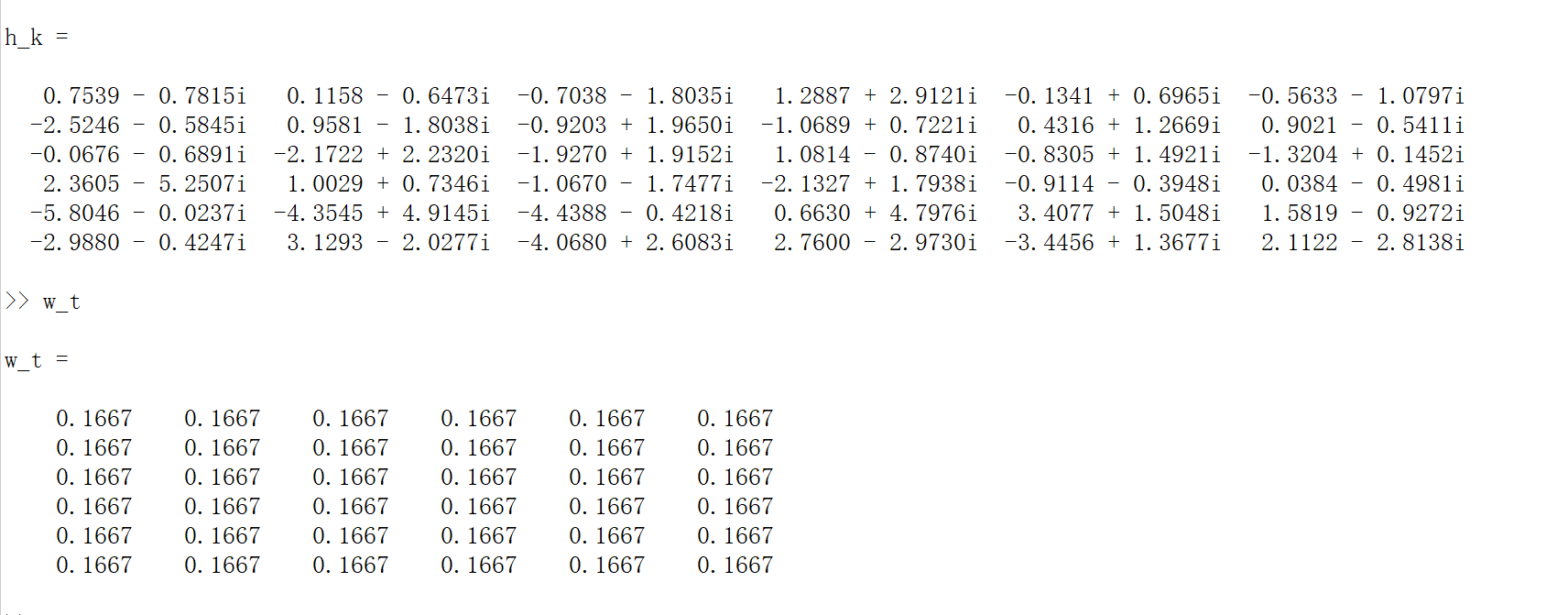Errors Occurred
MOSEK warning 52: A numerically large lower bound value 1.4e+12 is specified for constraint '' (30).
MOSEK warning 53: A numerically large upper bound value 1.4e+12 is specified for constraint '' (30).
MOSEK warning 52: A numerically large lower bound value -1.5e+12 is specified for constraint '' (154).
MOSEK warning 53: A numerically large upper bound value -1.5e+12 is specified for constraint '' (154).
MOSEK warning 52: A numerically large lower bound value 5.1e+12 is specified for constraint '' (155).
MOSEK warning 53: A numerically large upper bound value 5.1e+12 is specified for constraint '' (155).
MOSEK warning 52: A numerically large lower bound value 4.1e+12 is specified for constraint '' (156).
MOSEK warning 53: A numerically large upper bound value 4.1e+12 is specified for constraint '' (156).
MOSEK warning 52: A numerically large lower bound value -4.4e+12 is specified for constraint '' (157).
MOSEK warning 53: A numerically large upper bound value -4.4e+12 is specified for constraint '' (157).
MOSEK warning 52: A numerically large lower bound value 1.5e+11 is specified for constraint '' (158).
MOSEK warning 53: A numerically large upper bound value 1.5e+11 is specified for constraint '' (158).
MOSEK warning 52: A numerically large lower bound value 4.0e+12 is specified for constraint '' (159).
MOSEK warning 53: A numerically large upper bound value 4.0e+12 is specified for constraint '' (159).
MOSEK warning 52: A numerically large lower bound value 7.1e+12 is specified for constraint '' (160).
MOSEK warning 53: A numerically large upper bound value 7.1e+12 is specified for constraint '' (160).
MOSEK warning 52: A numerically large lower bound value -3.5e+12 is specified for constraint '' (161).
MOSEK warning 53: A numerically large upper bound value -3.5e+12 is specified for constraint '' (161).
MOSEK warning 52: A numerically large lower bound value -5.4e+12 is specified for constraint '' (162).
MOSEK warning 53: A numerically large upper bound value -5.4e+12 is specified for constraint '' (162).
Warning number 52 is disabled.
Warning number 53 is disabled.
Problem
Name :
Objective sense : min
Type : CONIC (conic optimization problem)
Constraints : 178
Cones : 99
Scalar variables : 487
Matrix variables : 0
Integer variables : 0
Optimizer started.
Presolve started.
Linear dependency checker started.
Linear dependency checker terminated.
Eliminator started.
Freed constraints in eliminator : 12
Eliminator terminated.
Eliminator started.
Freed constraints in eliminator : 0
Eliminator terminated.
Eliminator - tries : 2 time : 0.00
Lin. dep. - tries : 1 time : 0.01
Lin. dep. - number : 0
Presolve terminated. Time: 0.01
Problem
Name :
Objective sense : min
Type : CONIC (conic optimization problem)
Constraints : 178
Cones : 99
Scalar variables : 487
Matrix variables : 0
Integer variables : 0
Optimizer - threads : 16
Optimizer - solved problem : the primal
Optimizer - Constraints : 138
Optimizer - Cones : 100
Optimizer - Scalar variables : 469 conic : 469
Optimizer - Semi-definite variables: 0 scalarized : 0
Factor - setup time : 0.00 dense det. time : 0.00
Factor - ML order time : 0.00 GP order time : 0.00
Factor - nonzeros before factor : 5287 after factor : 5883
Factor - dense dim. : 0 flops : 3.81e+05
ITE PFEAS DFEAS GFEAS PRSTATUS POBJ DOBJ MU TIME
0 1.0e+12 8.9e+01 7.2e+11 0.00e+00 3.726873488e+02 -7.213475205e+11 1.0e+00 0.03
1 2.6e+11 2.2e+01 3.6e+11 -1.00e+00 6.844847024e+02 -7.212300211e+11 2.5e-01 0.08
2 9.8e+10 8.5e+00 2.2e+11 -1.00e+00 1.420974739e+03 -7.212000285e+11 9.6e-02 0.08
3 6.5e+10 5.7e+00 1.8e+11 -1.00e+00 2.131537099e+03 -7.211848752e+11 6.4e-02 0.08
4 2.5e+10 2.2e+00 1.1e+11 -1.00e+00 5.375691270e+03 -7.211727901e+11 2.5e-02 0.09
5 6.8e+09 5.9e-01 5.8e+10 -1.00e+00 2.057436471e+04 -7.211774861e+11 6.6e-03 0.09
6 5.3e+08 4.6e-02 1.6e+10 -1.00e+00 2.654029857e+05 -7.211767505e+11 5.2e-04 0.09
7 1.5e+04 1.3e-06 8.7e+07 -1.00e+00 9.431575114e+09 -7.129651938e+11 1.5e-08 0.09
Optimizer terminated. Time: 0.11
Interior-point solution summary
Problem status : UNKNOWN
Solution status : UNKNOWN
Primal. obj: 9.4315751140e+09 nrm: 7e+12 Viol. con: 7e+12 var: 0e+00 cones: 0e+00
Dual. obj: -7.1942241712e+11 nrm: 5e+07 Viol. con: 0e+00 var: 9e+01 cones: 0e+00
Optimizer summary
Optimizer - time: 0.11
Interior-point - iterations : 8 time: 0.09
Basis identification - time: 0.00
Primal - iterations : 0 time: 0.00
Dual - iterations : 0 time: 0.00
Clean primal - iterations : 0 time: 0.00
Clean dual - iterations : 0 time: 0.00
Simplex - time: 0.00
Primal simplex - iterations : 0 time: 0.00
Dual simplex - iterations : 0 time: 0.00
Mixed integer - relaxations: 0 time: 0.00
------------------------------------------------------------
Status: Failed
Optimal value (cvx_optval): NaN
My Code
cvx_begin
cvx_solver mosek
cvx_save_prefs
variable w(M,K) complex
expressions RR(K-1,K);
for k=1:K
w_temp1=0;w_temp2=0;w_temp5=0;
for i=k+1:K
w_temp1=w_temp1+pow_abs(h_k(k,:)*w_t(:,i),2);
w_temp2=w_temp2+pow_abs(h_k(k,:)*w(:,i),2);
w_temp5=w_temp5+2*real(h_k(k,:)*w_t(:,i)*w(:,i)'*h_k(k,:)')...
-(h_k(k,:)*w_t(:,i)*w_t(:,i)'*h_k(k,:)');
end
w_temp3=pow_abs(h_k(k,:)*w_t(:,k),2);
w_temp4=pow_abs(h_k(k,:)*w(:,k),2);
R_up(k)=log((w_temp1/noise+1+w_temp3/noise)/(w_temp1/noise+1))/log(2)+(quad_over_lin(h_k(k,:)*w(:,k),real(w_temp5)+noise)...
-(w_temp3/noise)/(w_temp1/noise+1))/((log(2)*(w_temp1/noise+1)+w_temp3*log(2)/noise)/(w_temp1/noise+1));
R_lp(k)=log(1+(w_temp3)/(w_temp1+noise))/log(2)+2*real(h_k(k,:)*w_t(:,k)*...
(h_k(k,:)*w(:,k)-h_k(k,:)*w_t(:,k)))/((w_temp1+noise)*log(2))...
-(w_temp3)*(w_temp2+noise+w_temp4)/((w_temp1+noise)*((w_temp1+noise)+w_temp3)*log(2))+w_temp3/((w_temp1+noise)*log(2));
end
for k=1:K-1
for i=k+1:K
w_temp6=0;w_temp7=0;
for j=k+1:K
w_temp6=w_temp6+pow_abs(h_k(i,:)*w_t(:,j),2);
w_temp7=w_temp7+pow_abs(h_k(i,:)*w(:,j),2);
end
w_temp8=pow_abs(h_k(i,:)*w_t(:,k),2);
w_temp9=pow_abs(h_k(i,:)*w(:,k),2);
RR(k,i)=log((w_temp6/noise+w_temp8/noise)/(w_temp6/noise+1))/log(2)+2*real(h_k(i,:)*w_t(:,k)*(h_k(i,:)*w(:,k)...
-h_k(i,:)*w_t(:,k))/noise)/((w_temp6/noise+1)*log(2))-(w_temp8/noise)*(w_temp7/noise+1+w_temp9/noise)...
/((w_temp6/noise+1)*((w_temp6/noise+1)+w_temp8/noise)*log(2))+(w_temp8/noise)/((w_temp6/noise+1)*log(2));
end
end
maximise sum(R_lp)
subject to
for k=1:K-1
for i=k+1:K
RR(k,i)>=R_up(k);
end
end
pow_pos(norm(w,'fro'),2)<=P_max;
cvx_end
I tried to normalize the noise, but it didn’t work
Initial value
I don’t know how to zoom in or out, but the solution failed, but R_ There is a value for lp, but the last value is particularly large. I saw in the forum that the value obtained from the failed solution is meaningless. Is it informative?
I would also like to ask, is there a conflict in taking both the upper and lower bounds for the same function in optimization problems?
Thank you very much for your answers. There are many things that beginners may not understand about CVX





